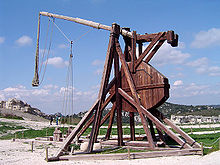
Raimon Escrivan
Encyclopedia

Toulouse
Toulouse is a city in the Haute-Garonne department in southwestern FranceIt lies on the banks of the River Garonne, 590 km away from Paris and half-way between the Atlantic Ocean and the Mediterranean Sea...
troubadour
Troubadour
A troubadour was a composer and performer of Old Occitan lyric poetry during the High Middle Ages . Since the word "troubadour" is etymologically masculine, a female troubadour is usually called a trobairitz....
. He may be identified with the canon
Canon (priest)
A canon is a priest or minister who is a member of certain bodies of the Christian clergy subject to an ecclesiastical rule ....
Raimundus Scriptor of Saint-Étienne in Toulouse or perhaps Raimon de Costiran, a victim of the Papal Inquisition at Avinhonet in 1242. His surname, Escrivan, means "writer" (Latin scriptor) and was commonly adopted by notaries at that time.
While trapped in the city during the Siege of Toulouse in 1218, he wrote a mock tenso
Tenso
A tenso is a style of Occitan song favoured by the troubadours. It takes the form of a debate in which each voice defends a position on a topic relating to love or ethics. Closely related genres include the partimen and the cobla exchange...
between a trebuchet
Trebuchet
A trebuchet is a siege engine that was employed in the Middle Ages. It is sometimes called a "counterweight trebuchet" or "counterpoise trebuchet" in order to distinguish it from an earlier weapon that has come to be called the "traction trebuchet", the original version with pulling men instead of...
(trabuquet) and a siege engine
Siege engine
A siege engine is a device that is designed to break or circumvent city walls and other fortifications in siege warfare. Some have been operated close to the fortifications, while others have been used to attack from a distance. From antiquity, siege engines were constructed largely of wood and...
called a "cat" (cata). Senhors, l'autrier vi ses falhida, as it begins, has been interpreted as cleverly disguised obscenity, but there is no reason not to take it at face value. During the siege a trebuchet was constructed by the citizens and successfully employed to destroy the besiegers' cat, just as the trabuquet of the poem defeats the cata. The Chanson de la Croisade Albigeoise
Chanson de la Croisade Albigeoise
The Song of the Albigensian Crusade is an Old Occitan epic poem narrating events of the Albigensian Crusade from March 1208 to June 1219. Modelled on the Old French chanson de geste, it was composed in two distinct parts: William of Tudela wrote the first towards 1213, and an anonymous continuator...
contains a description of the siege (from a Toulousain viewpoint) which echoes the tenor of Escrivan's song.

